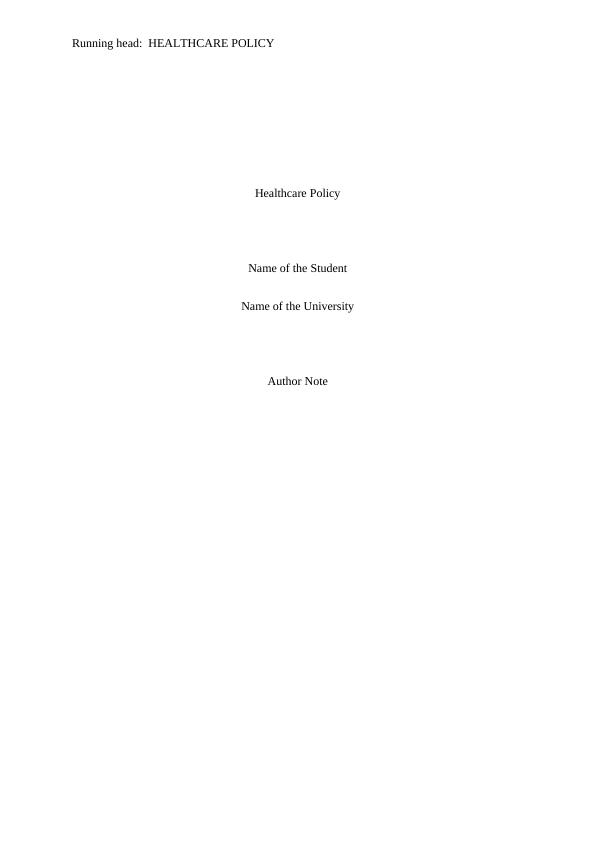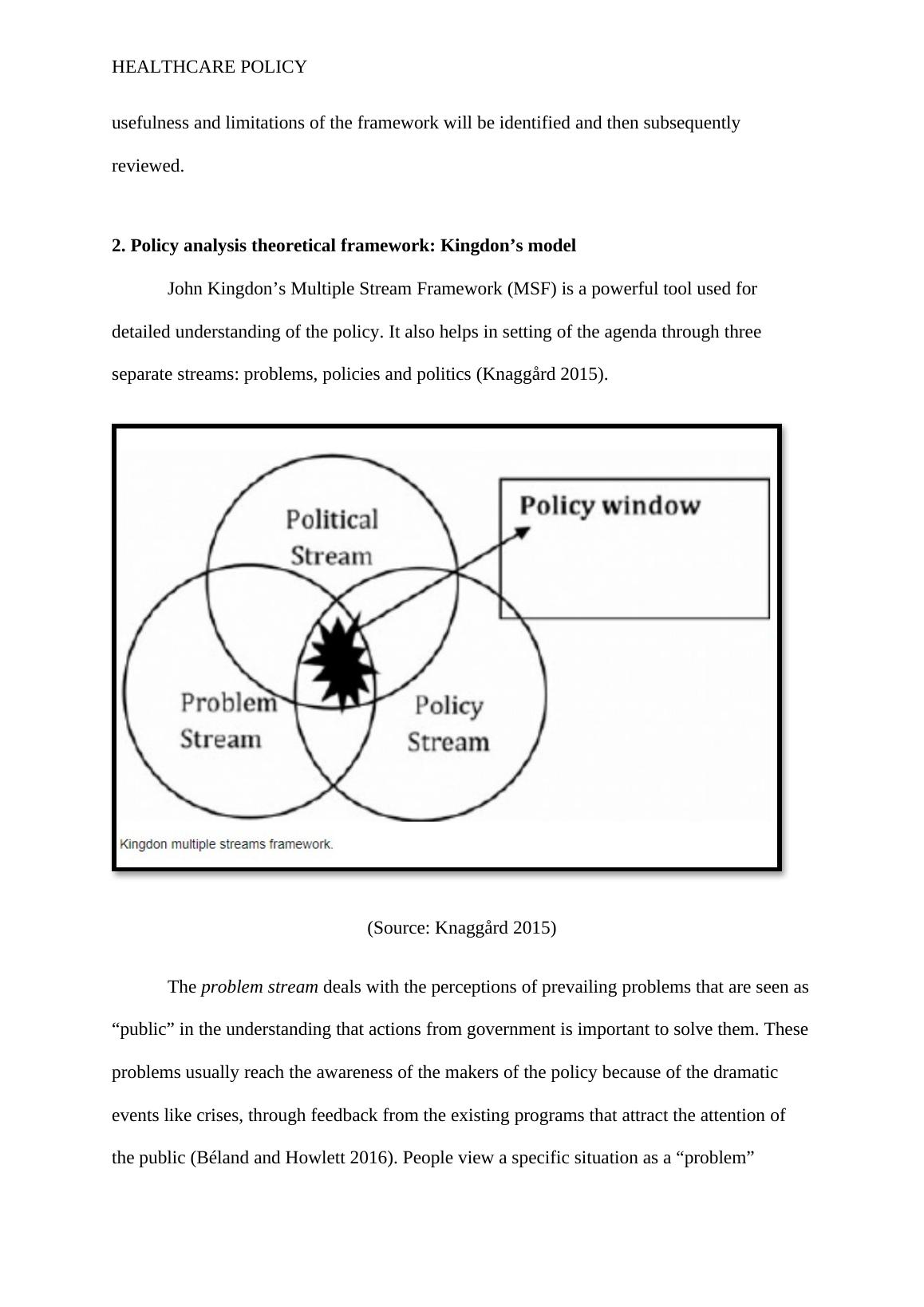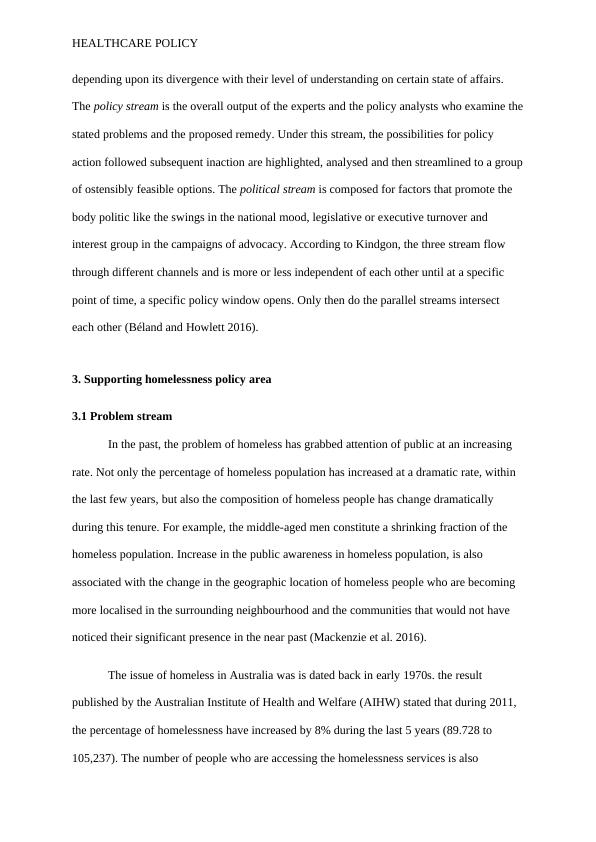Healthcare Policy
Added on 2023-01-10
13 Pages3503 Words95 Views
Running head: HEALTHCARE POLICY
Healthcare Policy
Name of the Student
Name of the University
Author Note
Healthcare Policy
Name of the Student
Name of the University
Author Note

HEALTHCARE POLICY
1. Introduction
According to the definition of National Coalition for the Homeless (2017), a person is
homeless when he or she lacks any permanent, standard and adequate residence during the
night-time. There has always been homeless person in developed countries like the USA, UK
and Australia. The economic consequences and demographic factors have fluctuated, along
with the proportion and percentage of the homeless population. However, there are
comparatively fixed skid rows where the homeless population congregate (Mackenzie et al.
2016). The government of Australia recognises homeless as a complex issue that affects a
significant section of the Australian population. It requires systematic efforts across different
agencies, sectors and other community level. While the territory and state level governments
are responsible for the delivery of service, the Commonwealth supports state and the other
territory government in their role for delivering services to the people who are homeless in
Australia and to those who are on a verge of being homeless. The main funding for
development of the policy and homeless and procuring proper care for the people who are
homeless mainly comes from the National Affordable Housing agreement (NAHA) and the
National Partnership Agreement on Homelessness (NPAH). According to the budget
published on 2017-18, the government of Australia is working with territories and states in
order to reform NAHA and NPAH into a new National Housing and Homelessness
agreement NHHA (Australian Government Department of Social Services, 2017). The
following report will depict the Kingdon’s theoretical framework and analyse the homeless
policy area by the use of this model. The implementation of the current homeless policy will
be done under the perspective of the NSW government. The implementation of the present
NSW multidisciplinary interagency policy will be examined while analysing the alternative
approaches and their subsequent impacts from the point of view of public health. The overall
1. Introduction
According to the definition of National Coalition for the Homeless (2017), a person is
homeless when he or she lacks any permanent, standard and adequate residence during the
night-time. There has always been homeless person in developed countries like the USA, UK
and Australia. The economic consequences and demographic factors have fluctuated, along
with the proportion and percentage of the homeless population. However, there are
comparatively fixed skid rows where the homeless population congregate (Mackenzie et al.
2016). The government of Australia recognises homeless as a complex issue that affects a
significant section of the Australian population. It requires systematic efforts across different
agencies, sectors and other community level. While the territory and state level governments
are responsible for the delivery of service, the Commonwealth supports state and the other
territory government in their role for delivering services to the people who are homeless in
Australia and to those who are on a verge of being homeless. The main funding for
development of the policy and homeless and procuring proper care for the people who are
homeless mainly comes from the National Affordable Housing agreement (NAHA) and the
National Partnership Agreement on Homelessness (NPAH). According to the budget
published on 2017-18, the government of Australia is working with territories and states in
order to reform NAHA and NPAH into a new National Housing and Homelessness
agreement NHHA (Australian Government Department of Social Services, 2017). The
following report will depict the Kingdon’s theoretical framework and analyse the homeless
policy area by the use of this model. The implementation of the current homeless policy will
be done under the perspective of the NSW government. The implementation of the present
NSW multidisciplinary interagency policy will be examined while analysing the alternative
approaches and their subsequent impacts from the point of view of public health. The overall

HEALTHCARE POLICY
usefulness and limitations of the framework will be identified and then subsequently
reviewed.
2. Policy analysis theoretical framework: Kingdon’s model
John Kingdon’s Multiple Stream Framework (MSF) is a powerful tool used for
detailed understanding of the policy. It also helps in setting of the agenda through three
separate streams: problems, policies and politics (Knaggård 2015).
(Source: Knaggård 2015)
The problem stream deals with the perceptions of prevailing problems that are seen as
“public” in the understanding that actions from government is important to solve them. These
problems usually reach the awareness of the makers of the policy because of the dramatic
events like crises, through feedback from the existing programs that attract the attention of
the public (Béland and Howlett 2016). People view a specific situation as a “problem”
usefulness and limitations of the framework will be identified and then subsequently
reviewed.
2. Policy analysis theoretical framework: Kingdon’s model
John Kingdon’s Multiple Stream Framework (MSF) is a powerful tool used for
detailed understanding of the policy. It also helps in setting of the agenda through three
separate streams: problems, policies and politics (Knaggård 2015).
(Source: Knaggård 2015)
The problem stream deals with the perceptions of prevailing problems that are seen as
“public” in the understanding that actions from government is important to solve them. These
problems usually reach the awareness of the makers of the policy because of the dramatic
events like crises, through feedback from the existing programs that attract the attention of
the public (Béland and Howlett 2016). People view a specific situation as a “problem”

HEALTHCARE POLICY
depending upon its divergence with their level of understanding on certain state of affairs.
The policy stream is the overall output of the experts and the policy analysts who examine the
stated problems and the proposed remedy. Under this stream, the possibilities for policy
action followed subsequent inaction are highlighted, analysed and then streamlined to a group
of ostensibly feasible options. The political stream is composed for factors that promote the
body politic like the swings in the national mood, legislative or executive turnover and
interest group in the campaigns of advocacy. According to Kindgon, the three stream flow
through different channels and is more or less independent of each other until at a specific
point of time, a specific policy window opens. Only then do the parallel streams intersect
each other (Béland and Howlett 2016).
3. Supporting homelessness policy area
3.1 Problem stream
In the past, the problem of homeless has grabbed attention of public at an increasing
rate. Not only the percentage of homeless population has increased at a dramatic rate, within
the last few years, but also the composition of homeless people has change dramatically
during this tenure. For example, the middle-aged men constitute a shrinking fraction of the
homeless population. Increase in the public awareness in homeless population, is also
associated with the change in the geographic location of homeless people who are becoming
more localised in the surrounding neighbourhood and the communities that would not have
noticed their significant presence in the near past (Mackenzie et al. 2016).
The issue of homeless in Australia was is dated back in early 1970s. the result
published by the Australian Institute of Health and Welfare (AIHW) stated that during 2011,
the percentage of homelessness have increased by 8% during the last 5 years (89.728 to
105,237). The number of people who are accessing the homelessness services is also
depending upon its divergence with their level of understanding on certain state of affairs.
The policy stream is the overall output of the experts and the policy analysts who examine the
stated problems and the proposed remedy. Under this stream, the possibilities for policy
action followed subsequent inaction are highlighted, analysed and then streamlined to a group
of ostensibly feasible options. The political stream is composed for factors that promote the
body politic like the swings in the national mood, legislative or executive turnover and
interest group in the campaigns of advocacy. According to Kindgon, the three stream flow
through different channels and is more or less independent of each other until at a specific
point of time, a specific policy window opens. Only then do the parallel streams intersect
each other (Béland and Howlett 2016).
3. Supporting homelessness policy area
3.1 Problem stream
In the past, the problem of homeless has grabbed attention of public at an increasing
rate. Not only the percentage of homeless population has increased at a dramatic rate, within
the last few years, but also the composition of homeless people has change dramatically
during this tenure. For example, the middle-aged men constitute a shrinking fraction of the
homeless population. Increase in the public awareness in homeless population, is also
associated with the change in the geographic location of homeless people who are becoming
more localised in the surrounding neighbourhood and the communities that would not have
noticed their significant presence in the near past (Mackenzie et al. 2016).
The issue of homeless in Australia was is dated back in early 1970s. the result
published by the Australian Institute of Health and Welfare (AIHW) stated that during 2011,
the percentage of homelessness have increased by 8% during the last 5 years (89.728 to
105,237). The number of people who are accessing the homelessness services is also

End of preview
Want to access all the pages? Upload your documents or become a member.
Related Documents
Analyzing Homelessness Using Kingdon's Frameworklg...
|12
|3145
|116
Social Policy: Housing Support and Homelessness in Australialg...
|18
|3980
|483
Australian Reforms to Handle Homelessnesslg...
|4
|508
|292
Health in all policieslg...
|12
|2403
|110
Australian Housing policieslg...
|8
|1557
|56
Australian Housing Policy: Overview, Implementation, and Sustainabilitylg...
|13
|3136
|338
